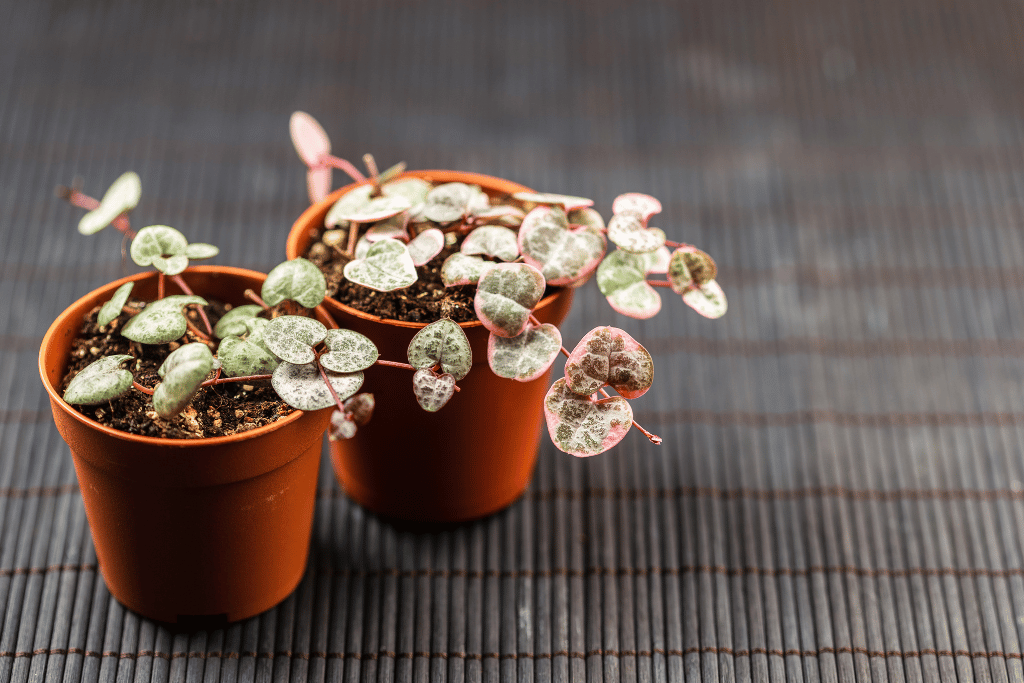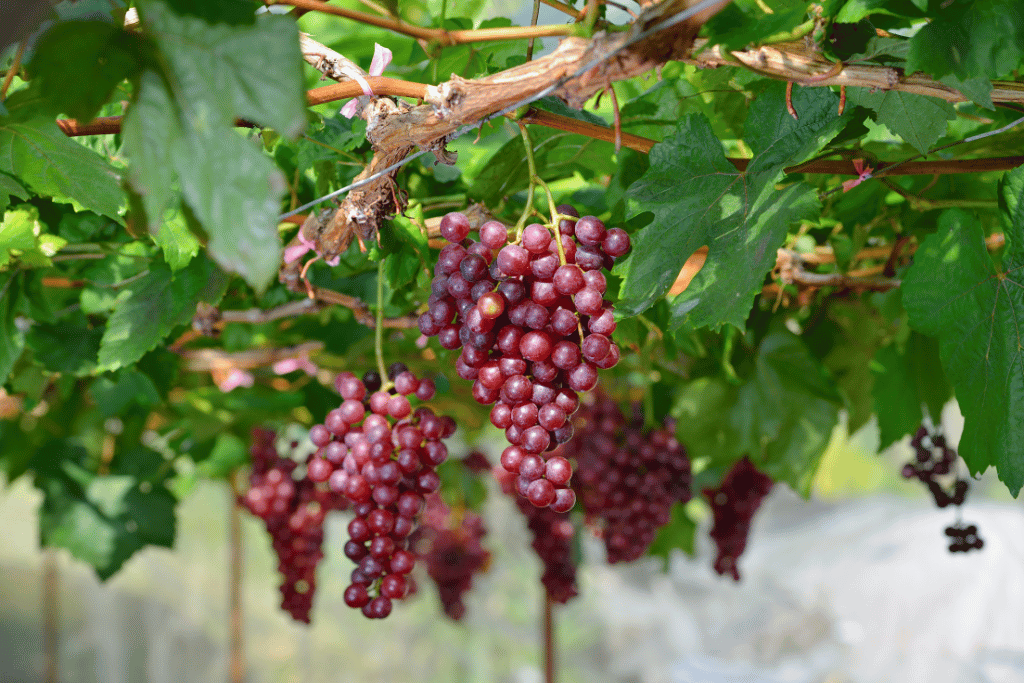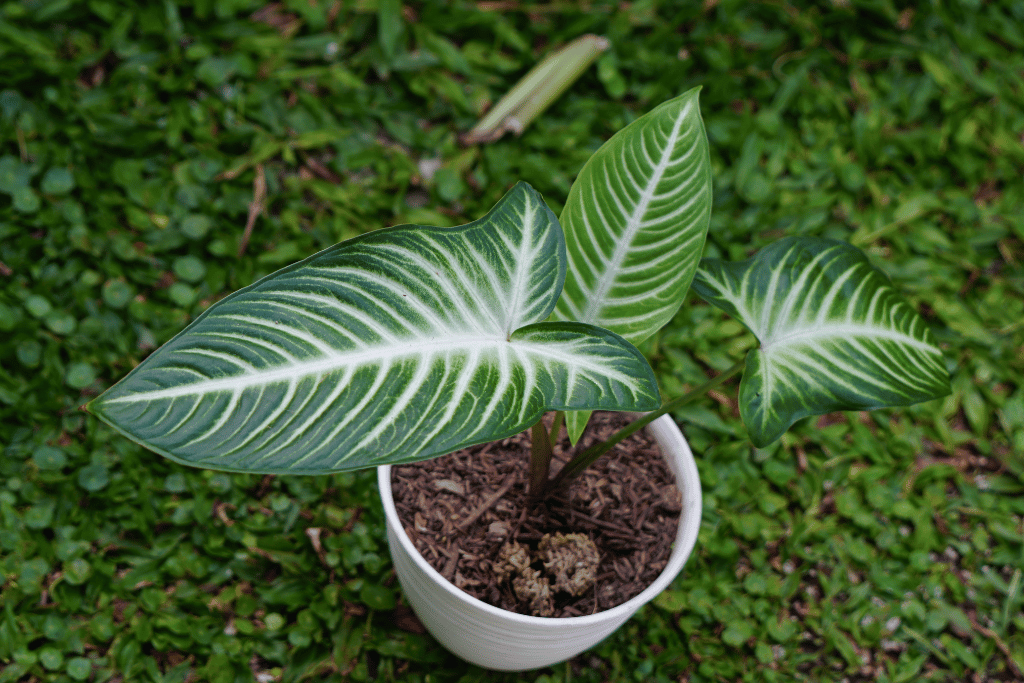
Xanthosoma Lindenii is an amazing plant flaunting unique leaves, which feature a striking combination of deep green coloration and intricate silvery-white veining. The color-combo resembles intricate brushstrokes on a canvas. It’s true art work!
Moreover, the contrast between the lush green background and the intricate white patterns makes Xanthosoma Lindenii a captivating centerpiece in any setting, adding a touch of sophistication and natural beauty.
This article sheds light on the key characteristics, care requirements and problems associated with this plant. So, without much ado, let’s begin.
Scientific Name and Origin
Xanthosoma lindenii gets its name from the Greek words “xanthos,” meaning yellow, and “soma,” meaning body. The specific epithet “lindenii” honors Belgian botanist Jean Jules Linden, who made significant contributions to the field of botany in the 19th century.
This plant is native to the lush rainforests of Central and South America, primarily in countries like Brazil, Ecuador, and Peru. It thrives in the warm, humid climates of these regions.
Fun Facts
- Xanthosoma lindenii is often referred to as the “Jungle Elephant Ear” due to its large, ear-shaped leaves.
- The plant is sometimes called “Variegated Taro” because of its variegated, or mottled, leaf pattern.
- It can reach a height of 2 to 4 feet when grown indoors.
- Despite its tropical origins, it can be cultivated as an indoor houseplant in various parts of the world.
Habitat and Toxicity
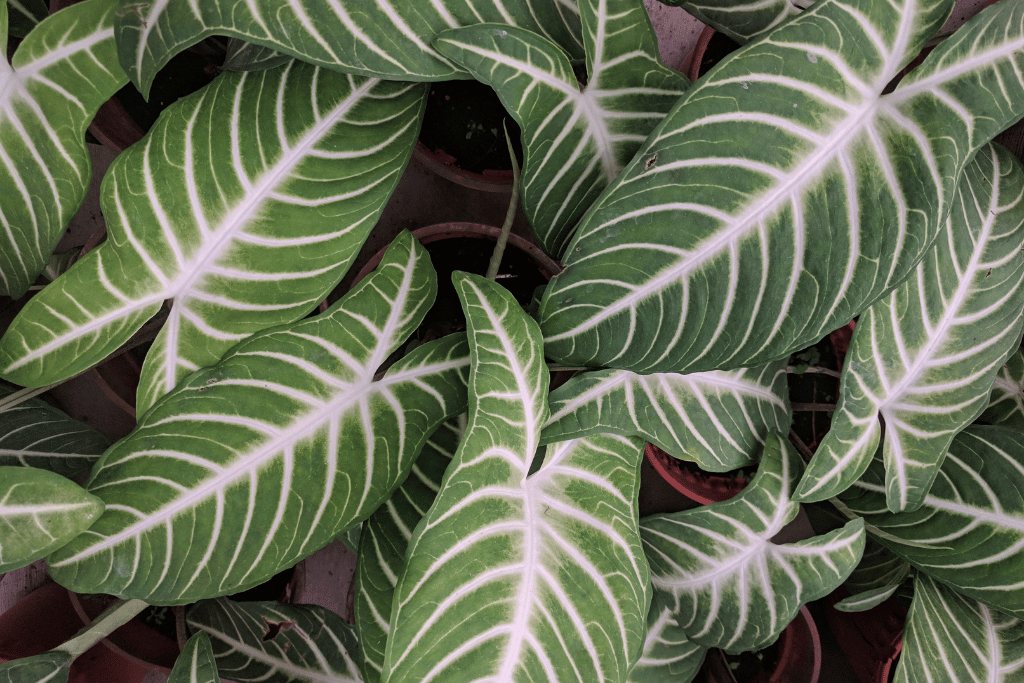
In the wild, you can find Xanthosoma lindenii in the understory of dense rainforests. It prefers well-draining, rich, and moist soil. While this plant is captivating in appearance, it’s essential to handle it with care. All parts of the plant contain calcium oxalate crystals, which can cause irritation and discomfort if ingested. It’s advisable to keep this plant out of reach of children and pets.
Appearance
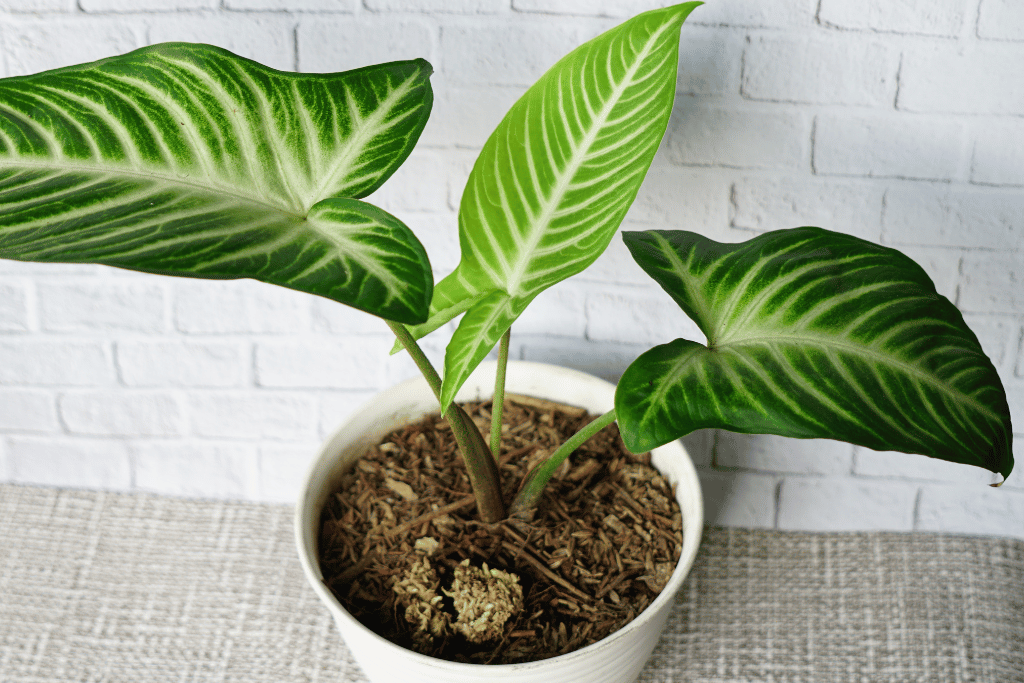
The striking appearance of Xanthosoma lindenii is what makes it a favorite among plant enthusiasts. The plant features large, arrowhead-shaped leaves that can grow up to a foot in length. These leaves are dark green with irregular, creamy-white to pale yellow marbling, making them incredibly attractive.
Features of Xanthosoma Lindenii
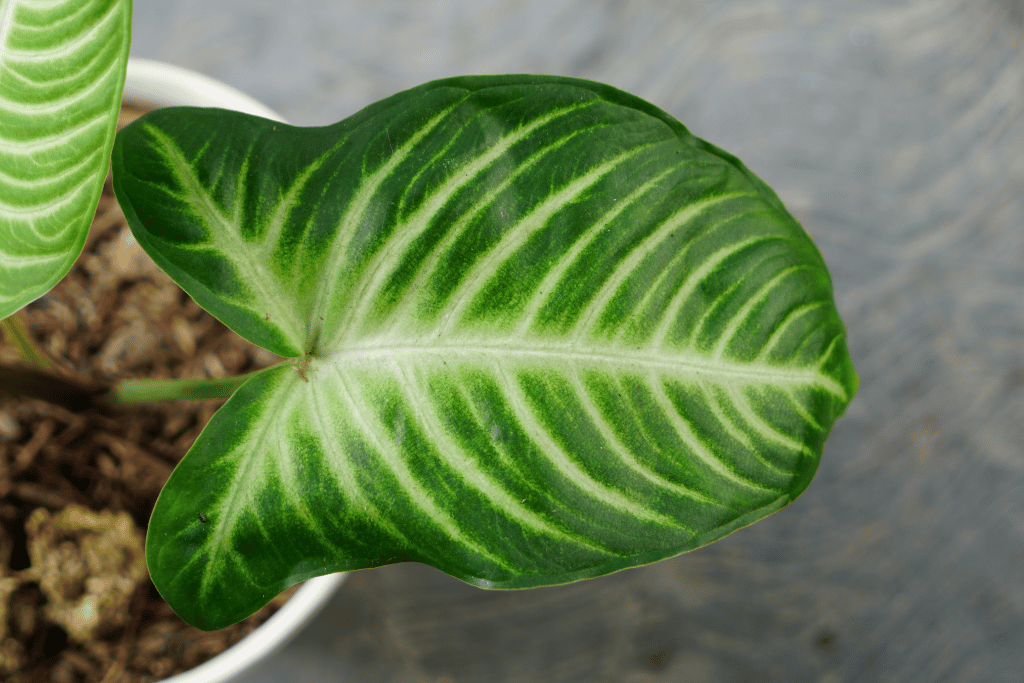
Xanthosoma lindenii possesses several notable features that set it apart from other houseplants:
Variegated Foliage: The most prominent feature of this plant is its variegated foliage. The marbled pattern on the leaves gives them a unique and striking appearance.
Sturdy Stems: The stems of Xanthosoma lindenii are sturdy and can support the weight of its large leaves without drooping.
Indoor Adaptability: While it’s native to tropical rainforests, this plant can adapt well to indoor conditions, provided it receives proper care.
Air-Purifying Qualities: Like many other indoor plants, Xanthosoma lindenii helps improve indoor air quality by removing toxins and increasing humidity.
Xanthosoma Lindenii Care Guide: Nurturing Your Tropical Beauty
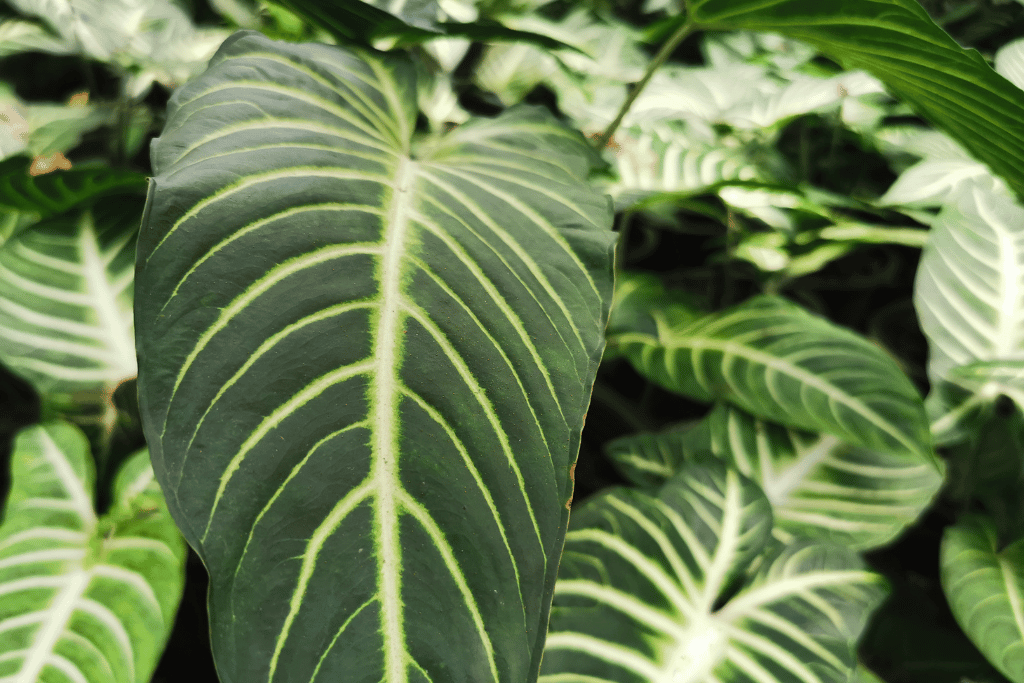
Caring for Xanthosoma lindenii, commonly known as the Variegated Taro or Jungle Elephant Ear, is not difficult. With the right knowledge, you can keep it in top-notch shape. Here’s what you need to do:
Light Requirements
Proper lighting is crucial for the growth and well-being of your Xanthosoma lindenii. This tropical plant thrives in bright, indirect sunlight, which mimics its native rainforest habitat. When placed in too much direct sunlight, its leaves can scorch and develop unsightly brown patches.
Ideal Light Conditions: Provide your plant with bright, filtered light. Placing it near a north or east-facing window is often ideal. If natural light is limited, consider using grow lights designed for houseplants to supplement its illumination needs.
Avoid Direct Sunlight: Direct sunlight, especially during the harsh midday hours, can be harmful. If your plant receives direct sunlight, use sheer curtains or blinds to diffuse the light and protect its delicate leaves.
Monitor Light Levels: Observe your plant’s response to its current location. If you notice the leaves becoming pale or scorched, it may need adjustments in its lighting conditions.
Watering
Proper watering is a fundamental aspect of Xanthosoma lindenii care. This tropical beauty thrives in consistently moist soil but can suffer if it becomes waterlogged.
Check Soil Moisture: Before watering, check the moisture level of the soil. Stick your finger about an inch into the soil. If it feels dry, it’s time to water.
Water Thoroughly: When it’s time to water, add water until you see it draining from the bottom of the pot. Ensure proper drainage to prevent waterlogging.
Watering Frequency: The frequency of watering depends on factors such as temperature, humidity, and the size of the pot. Generally, you may need to water every 1-2 weeks, but always rely on soil moisture as your primary indicator.
Use Room-Temperature Water: Avoid using cold or chlorinated water. Room-temperature, filtered water is best for your plant.
Temperature and Humidity
Maintaining the right temperature and humidity levels is crucial for the well-being of your Xanthosoma lindenii. As a tropical plant, it thrives in warm, humid conditions that mirror its native habitat.
Ideal Temperature: Keep your plant in an environment with temperatures ranging from 65°F to 85°F (18°C to 29°C). Avoid exposure to drafts and cold air, especially during the winter months.
Humidity Needs: High humidity levels are essential. To increase humidity around your plant, you can:
- Mist Regularly: Use a spray bottle to mist the leaves, ensuring the water droplets are fine and not too heavy.
- Use a Humidifier: Invest in a humidifier to maintain consistent humidity levels in the room.
- Tray of Water: Place a tray of water filled with pebbles near the plant. As the water evaporates, it will increase humidity.
Fertilization
Proper fertilization is essential for the healthy growth of your Xanthosoma lindenii. During the growing season, which typically spans from spring through summer, you should provide your plant with the necessary nutrients.
Balanced Fertilizer: Use a balanced, water-soluble fertilizer with a ratio of 10-10-10 or 20-20-20, diluted to half strength. Fertilize every 4-6 weeks during the growing season.
Application Method: Apply the fertilizer to moist soil to prevent root burn. Follow the manufacturer’s recommendations for application rates.
Avoid Over-Fertilizing: Over-fertilization can lead to salt buildup in the soil, causing harm to your plant. Always follow recommended guidelines and avoid fertilizing during the dormant winter months.
Potting Mix
Choosing the right potting mix is crucial for the overall health of your Xanthosoma lindenii. The mix should provide adequate drainage while retaining moisture and nutrients.
Well-Draining Mix: Use a well-draining potting mix that contains organic matter. A mix designed for aroids or tropical plants is typically suitable.
Repotting: As your plant grows, it may outgrow its current container. Repot every 2-3 years during the spring, upgrading to a slightly larger pot as needed.
Root Health: When repotting, inspect the roots for any signs of rot or disease. Trim away any damaged roots and use fresh potting mix to encourage healthy growth.
Pruning and Maintenance
Regular maintenance ensures your Xanthosoma lindenii stays healthy and attractive. Pruning is an essential part of this process.
Remove Yellowing Leaves: As your plant matures, lower leaves may turn yellow and decline. Remove these leaves to promote the growth of new, healthy foliage.
Cleaning: Dust can accumulate on your plant’s leaves, reducing its ability to photosynthesize. Wipe the leaves gently with a damp cloth to keep them clean and free from dust.
Support: Due to its large, heavy leaves, your Xanthosoma lindenii may benefit from staking or support to prevent the stems from bending or breaking.
Propagation and Repotting Guide for Xanthosoma Lindenii
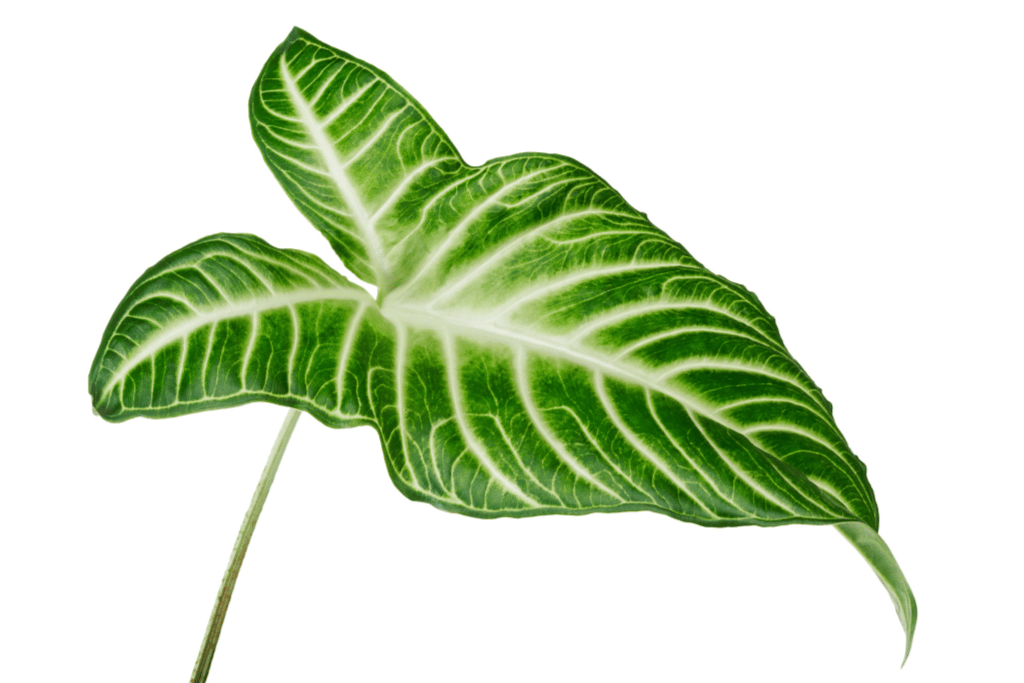
Propagating and repotting Xanthosoma lindenii can be exciting and necessary steps in its care journey. Whether you want to expand your plant collection or your beloved Xanthosoma lindenii has outgrown its current home, this section will guide you through the processes of propagation and repotting.
Xanthosoma Lindenii Propagation
Xanthosoma lindenii can be propagated through two primary methods: division and stem cuttings.
1. Division
Tools Needed:
- Sharp, clean knife or scissors
- Small pots or containers
- Fresh potting mix
Steps:
Prepare the Parent Plant: Ensure your parent plant is healthy and has multiple stems or rhizomes. Propagation is best done during the growing season, typically spring or early summer.
Gently Remove the Plant: Carefully remove the plant from its pot, taking care not to damage the roots. Shake off excess soil to expose the rhizomes.
Separate the Rhizomes: Using a sharp knife or scissors, divide the rhizomes into sections. Each section should have at least one stem and a portion of the rhizome with roots.
Plant in New Containers: Plant each divided section in a small pot or container filled with fresh potting mix. Ensure the stem is above the soil surface, and the roots are buried.
Water and Care: Water the newly potted divisions thoroughly and place them in a location with bright, indirect light. Follow the standard care guidelines for Xanthosoma lindenii as discussed in the care guide section.
2. Stem Cuttings
Select Healthy Stem Cuttings: Choose a healthy stem with several leaves. Ensure it’s free from pests or diseases.
Cut the Stem: Use clean scissors or pruning shears to make a clean cut below a leaf node (the area where leaves are attached to the stem). Aim for a cutting that is about 4-6 inches long.
Prepare the Cutting: Remove any lower leaves from the cutting, leaving a few at the top. This reduces moisture loss and encourages root development.
Plant in Containers: Place the cutting in a small pot or container filled with fresh potting mix. Bury the cut end about 1-2 inches deep.
Provide Adequate Humidity: Cover the cutting and pot with a clear plastic bag or a plastic dome to create a mini-greenhouse effect. This helps maintain high humidity around the cutting.
Place in Indirect Light: Put the container with the cutting in a location with bright, indirect light. Avoid direct sunlight, as it can scorch the cutting.
Monitor and Water: Keep an eye on the cutting and ensure the soil remains consistently moist but not waterlogged.
Mist the cutting and inside the plastic covering to maintain humidity.
Transplant When Rooted: After several weeks to a few months, depending on conditions, the cutting will develop roots. You can transplant it into a larger pot following the repotting guidelines below.
Xanthosoma Lindenii Repotting
Repotting your Xanthosoma lindenii is essential when it outgrows its current container or when you notice signs of declining health, such as slowed growth or root congestion. Repotting allows for the renewal of the potting mix, provides more space for root growth, and prevents the plant from becoming root-bound.
Tools Needed:
- Larger pot or container
- Fresh potting mix
- Trowel or gardening gloves
Steps:
Choose the Right Time: Spring is the best time to repot Xanthosoma lindenii when it’s actively growing. Ensure the plant is healthy and free from any pests or diseases.
Select a Larger Container: Choose a pot that is 1-2 inches larger in diameter than the current one. Ensure the new pot has drainage holes at the bottom.
Prepare the Potting Mix: Use a well-draining potting mix with organic matter. Fill the new pot about one-third full with fresh mix.
Remove the Plant: Gently remove the plant from its current pot, being careful not to damage the roots. If the roots are tightly wound around the root ball, you can gently tease them apart to encourage new growth.
Place in New Container: Position the plant in the center of the new pot, making sure it sits at the same depth as it did in the old pot. Add more potting mix around the sides, ensuring that the plant is stable and upright. Keep in mind the difference between potting soil and potting mix.
Water Thoroughly: After repotting, water the plant thoroughly to help settle the soil and remove any air pockets around the roots.
Resume Care Routine: Return the plant to its preferred location with the right light, temperature, and humidity conditions. Follow the care guide provided earlier to maintain its health and well-being.
Challenges Associated With Xanthosoma Lindenii
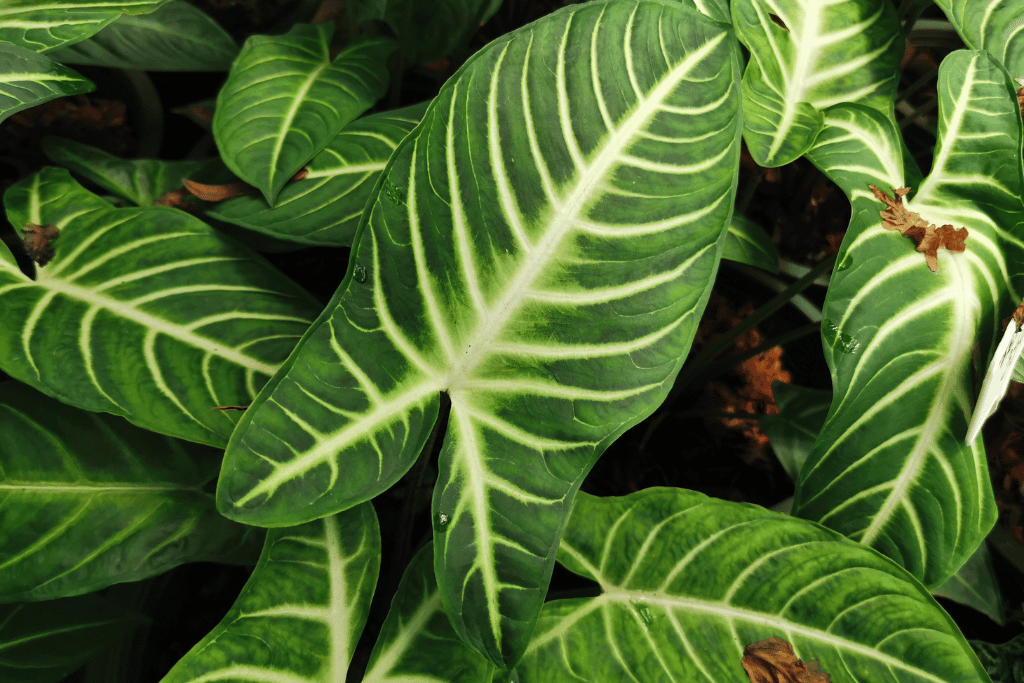
While caring for Xanthosoma lindenii can be a rewarding experience, it comes with its share of challenges and potential issues that you should be aware of:
Toxicity: Remember that all parts of this plant contain calcium oxalate crystals, making it toxic if ingested. Exercise caution and keep it out of reach of children and pets.
Pests: Occasionally, your plant may attract common houseplant pests like spider mites or aphids. Regularly inspect the leaves and stems, and treat any infestations promptly to prevent them from spreading.
Disease: Xanthosoma lindenii can be susceptible to root rot if the soil is consistently waterlogged. Proper watering practices are essential to avoid this issue.
Leaf Issues: Keep an eye out for yellowing or browning of leaves, which could be indicative of overwatering, underwatering, or insufficient light. Adjust your care routine accordingly.
Final Words
Xanthosoma lindenii, with its stunning variegated foliage, can be a captivating addition to your indoor space. By providing the right care, you can ensure its long-term health and beauty.
Pay attention to its light, water, temperature, and humidity needs, and follow a regular maintenance routine to keep it thriving. While challenges like toxicity and potential pests exist, with proper care and attention, you can enjoy the vibrant presence of this tropical beauty in your home for years to come.
Frequently Asked Questions (FAQ)
How long does a Xanthosoma lindenii last?
With proper care, Xanthosoma lindenii can live for many years, often several decades, as a houseplant. Regular maintenance, such as repotting and providing suitable growing conditions, can contribute to its longevity.
Is Xanthosoma lindenii considered a rare plant?
Xanthosoma lindenii is not extremely common but is becoming more popular among plant enthusiasts. Its rarity may vary depending on your location and the availability of the plant in local nurseries or online stores.
How can I prevent common issues like yellowing leaves or pests on my Xanthosoma lindenii?
To prevent yellowing leaves, ensure your plant receives adequate light without direct sunlight, maintain proper humidity, and water consistently. Regularly inspect your plant for pests like spider mites, mealybugs, or aphids and treat them promptly with appropriate measures, such as neem oil or insecticidal soap.
Can I grow Xanthosoma lindenii outdoors in a garden?
Xanthosoma lindenii can be grown outdoors in tropical or subtropical regions with mild winters. It thrives in well-drained, fertile soil and a shaded or partially shaded location. Be sure to protect it from frost and extreme temperature fluctuations.
Can I grow Xanthosoma lindenii indoors?
Yes, Xanthosoma lindenii can be grown indoors as a houseplant. Ensure it receives adequate light, humidity, and proper watering to keep it healthy.


